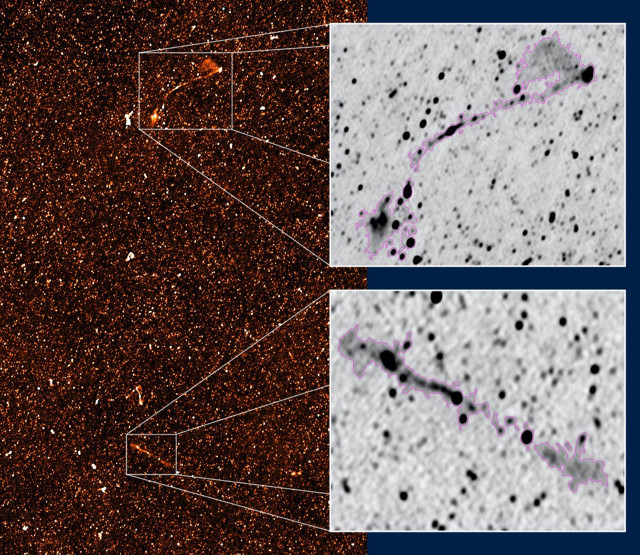
An article published in the journal “Monthly Notices of the Royal Astronomical Society” reports the discovery of two giant radio galaxies in a small portion of the sky, a discovery in theory very unlikely. A team of researchers led by Jacinta Delhaize of the University of Cape Town, South Africa, used data collected during the MIGHTEE survey conducted with the MeerKAT radio telescope. Giant radio galaxies are considered very rare, but are perhaps much more common than expected, a possibility that could have an impact on studying the formation and evolution of galaxies.
Radio galaxies are sources of powerful radio emissions thanks to their active galactic nuclei, powered by supermassive black holes that heat the materials around them so much that they generate powerful electromagnetic emissions. In giant radio galaxies, radio emissions can extend for several million light-years due to jets of energetic particles emitted from the black hole.
Giant radio galaxies are the rarest subcategory, yet the MIGHTEE (MeerKAT International GHz Tiered Extragalactic Exploration) survey made it possible to discover two of them, cataloged as MGTC J095959.63+024608.6. and MGTC J100016.84+015133.0, in a small portion of the sky. The top image (Courtesy I. Heywood (Oxford/Rhodes/SARAO). All rights reserved) shows the two giant radio galaxies seen by MeerKAT. The bottom image (Courtesy I. Heywood (Oxford/Rhodes/SARAO). All rights reserved) shows a portion of the radio map of the sky in the MIGHTEE survey with the two giant radio galaxies in the insets.
If this isn’t an extraordinary coincidence, it means that giant radio galaxies are more common than expected, and a new instrument with unprecedented sensitivity like the MeerKAT radio telescope is finally discovering them. In fact, the area where the two giant radio galaxies were discovered was already observed with other radio telescopes without identifying them.
Even on a theoretical level, some models describing the evolution of galaxies predict that giant radio galaxies are common and very ancient. Ivan Delvecchio of the Italian National Institute of Astrophysics in Milan, one of the authors of this study, explained that this scenario is also supported by the properties of the galaxies observed at different frequencies. That’s because they show little activity concerning star formation and the central supermassive black hole, which indicate that they must have faded over time.
This discovery could have important consequences on research into the evolution of galaxies. Marisa Brienza of the University of Bologna, another associate of the Italian National Institute of Astrophysics and also one of the authors of the study, explained that the fossil radiation traced by the enormous radio jets of the two giant radio galaxies discovered could hide valuable clues in the reconstruction of the phases of their life.
Other analyzes of the data collected during the MIGHTEE survey could reveal the presence of further hitherto unknown radio galaxies. This would prove again the usefulness of the MeerKAT radio telescope, which will be augmented with the addition of other antennas. MeerKAT is a precursor of SKA, the next generation radio telescope into which it will be integrated over the next few years. In essence, there will be many possibilities to test whether giant radio galaxies are indeed common.


